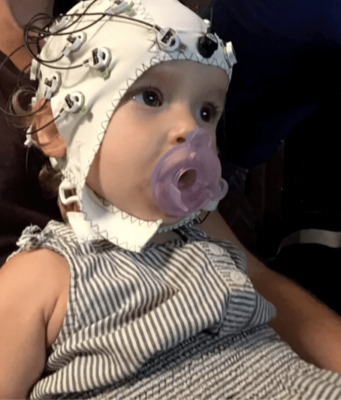Uterine torsion is a very rare and critical obstetric emergency characterized by the uterus rotating more than 45 degrees around its longitudinal axis, predominantly occurring at the cervix-uterine corpus junction. Despite its rare occurrence, this condition can affect individuals across various reproductive groups. Oligohydramnios, defined by an amniotic fluid volume of 2 cm or less in the single deepest vertical pocket, is associated with this condition during pregnancy. Uterine torsion poses significant risks, including severe maternal and perinatal consequences such as placental abruption, maternal mortality, and intrauterine fetal demise.
In this case presentation, we detail a specific case of a woman who encountered uterine torsion during pregnancy, leading to complications such as ‘uteroplacental’ and ‘fetoplacental’ insufficiency, severe fetal growth restriction, and persistent oligohydramnios throughout the gestation period.
Introduction of Uterine Torsion
Uterine torsion, first documented in 1861, remains an exceedingly rare obstetric condition, with just over 200 cases reported in the past century [1]. This condition involves the uterus rotating more than 45 degrees and up to 180 degrees around its longitudinal axis [2]. Due to its exceptional rarity, many obstetricians and gynecologists may encounter this obstetrical emergency only once in their professional careers [3]. The primary indicators of uterine torsion during pregnancy typically include abdominal pain, changes in fetal heart rate, and a failure of cervical dilatation [4]. Detecting uterine torsion becomes even more challenging in asymptomatic cases [5]. Despite abdominal pain in pregnancy not readily raising suspicion of uterine torsion, severe acute instances can lead to complications such as placental abruption, maternal mortality, and intrauterine fetal demise [6,7]. Because of its nonspecific and elusive symptoms that may mimic other obstetric complications, especially placental abruption, diagnosing uterine torsion is intricate and often delayed until the patient undergoes operative intervention [8].
Obstetric Emergency Case Presentation [1]
Patient Profile
- Age: 20 years
- Gravidity: Primigravida
- Gestational Age: 32 weeks and four days
- Presenting Complaints: Lower abdominal pain persisted for two days, escalating significantly three to four hours before the presentation.
Medical History
- Occasional elevated blood pressure during the current pregnancy for one month
- Treatment: Oral labetalol 100 mg twice daily for the past two days
- History of hematinic injections at 16 weeks for anemia (Hemoglobin: 8g/dL)
- Previous hospitalizations:
- Threatened preterm labor at 24 weeks
- Admission at 28 weeks for mild oligohydramnios
Clinical Examination
- Blood Pressure: 130/90 mmHg
- Pulse Rate: 90 beats per minute
- Temperature: 98.2F
- Oxygen Saturation: 99% on room air
- Respiratory Rate: 16 breaths per minute
- Uterine Height: Corresponds to 26 weeks with a lag of six weeks
- Uterus: Well-relaxed, no tenderness
- Fetal Heart Rate: 140 beats per minute
- Vaginal Examination: Dark, altered blood; cervix not dilated or effaced
Investigations
- Blood Investigations (PIH Profile): Normal
- Hemoglobin: 11.5g/dL
- Ultrasonography Findings:
- Single, live intrauterine gestation at 25 weeks
- Stage 4 fetal growth restriction
- AFI: 0 cm (An hydramnios)
- Placenta at the fundus
- Fetal Heart Rate: 154 beats per minute
- EFW: 636 grams (<1 percentile)
- Biophysical Profile: 4/10
- Doppler findings: Uteroplacental and fetoplacental insufficiency
Management
- Emergency Lower Segment Cesarean Section
- Intraoperative Findings:
- Uterus dextrorotation over 90 degrees
- Left ovary and round ligament visible beyond the center of the abdomen
- Tortuous uterine artery

Figure 1: Intraoperative picture showing uterine torsion
Intraoperative image showing the uterus (arrow) and left-sided ovary (arrowhead) at the center.
Clinical Procedure and Neonatal Outcome
- No observed uterine anomalies, fibroids, or ovarian pathologies
- Uterus unresponsive to gentle palpation for rotation
- Senior obstetrician successfully manually rotated the uterus through manipulation
- Incision made towards the left from the midline
- No amniotic fluid presents
- Asphyxiated baby observed in a transverse lie, delivered through breech extraction
- Neonatal Details:
- Covered with thick meconium
- APGAR score: 3/10 at one minute, 5/10 at five minutes
- Birth weight: 700 grams
- Neonatal resuscitation performed
- Baby shifted to Neonatal Intensive Care Unit (NICU)
- Active management of the third stage of labor:
- Injection of oxytocin 10 IU intramuscularly administered after baby delivery
- The placenta, located in the upper segment, was removed
- Concealed abruption was noted during the procedure (Figure 2).
Figure 2: Intraoperative image showing concealed abruption
Concealed abruption of the placenta in the uterus (arrow) was noted during the procedure after delivery of the placenta located at the fundus.
Postoperative Recovery and Outcome
- The postoperative period proceeded without any puerperal complications.
- Postoperative Hemoglobin: 11 g/dL.
- The patient recovered satisfactorily and was discharged on the seventh day after suture removal.
- Unfortunately, the baby succumbed on the eighth day to cardiorespiratory arrest and an extremely low birth weight.
Discussion
Pregnancy introduces heightened congenital and physiologic rotations and obliquities in the uterus, increasing the likelihood of uterine torsion in gravid uteri compared to non-gravid ones [5]. Observable asymmetry stemming from congenital or acquired deformities like uterine fibroids, anomalies, or pelvic adhesions may predispose individuals to uterine torsion, particularly in the third trimester. Additionally, structural weaknesses, whether developmental or acquired, and angulation in the isthmic region can contribute to torsion [8].
Despite the wealth of literature, uterine torsion’s precise etiology remains elusive, seemingly unrelated to maternal age, parity, and gestational age. Jensen’s series noted transverse lie as the most common abnormal fetal presentation (72%) [7], though recent reviews suggest torsion typically occurs in a normal pelvis without pelvic pathology. Nevertheless, this specific case falls within the 30% of cases where a discernable cause is not identified [2,7].
Uterine torsion poses substantial risks to both the mother and fetus. Maternal complications commonly include hemodynamic shock and complete or partial placental abruption [6,8]. Fetal complications encompass hypoxia, antepartum hemorrhage, and the risk of fetal demise. Imaging modalities like USG, CT, and MRI provide valuable diagnostic insights. Unsuccessful attempts at detorsioning may necessitate delivery through a posterior low transverse hysterotomy [3].
In the presented case, a primigravida with persistent lower abdominal pain, severe fetal growth restriction, and anhydramnios was diagnosed during surgery. An unexpected finding of uterine torsion with concealed abruption placenta was revealed intraoperatively. The potential connection between torsion-induced uteroplacental insufficiency and subsequent severe fetal growth restriction cannot be dismissed due to limited existing literature on the subject.
Conclusion
Uterine torsion in pregnant women is a rare occurrence that may go undetected, potentially leading to severe consequences if overlooked. Therefore, healthcare professionals should consider uterine torsion as a possible differential diagnosis when a woman, irrespective of age, presents with acute abdominal pain and vaginal bleeding. The presented case serves as an illustration of how uterine torsion can result in significant complications during pregnancy, posing substantial risks of morbidity and mortality for both the mother and the baby. Once diagnosed, the primary objective of management is to restore normal uterine anatomy and address any complications stemming from uterine torsion.
References
- Gaikwad V, Aramandla S, Gaikwad S (January 18, 2024) A Case Report of Uterine Torsion: An Obstetric Emergency During Pregnancy. Cureus 16(1): e52538. doi:10.7759/cureus.52538
- Yin FL, Huang HX, Zhang M, et al.: Clinical analysis of uterine torsion and fibroids in full-term pregnancy: a case report and review of the literature. J Int Med Res. 2020, 48:030006052092040. 10.1177/0300060520920404
- Ulu I, Güneş MS, Kiran G, Gülşen MS: A rare cause of placental abruption: uterine torsion. J Clin Diagn Res. 2016, 10: QD06-7. 10.7860/JCDR/2016/16531.7071
- Fatih FF, Gowri V, Rao K: Uterine torsion in the second trimester of pregnancy followed by a successful-term pregnancy. BMJ Case Rep. 2012, 2012: bcr2012006359. 10.1136/bcr-2012-006359
- Havaldar N, Ashok K: Torsion of non-gravid uterus with ovarian cyst – an extremely rare case. Pan Afr Med J. 2014, 18:95. 10.11604/pamj.2014.18.95.1430
- Zullino S, Faiola S, Paganelli AM, Ferrazzi E: A case of abruption placentae due to the torsion of gravid uterus. Case Rep Obstet Gynecol. 2014, 2014:801616. 10.1155/2014/801616
- Cook KE, Jenkins SM: Pathologic uterine torsion associated with placental abruption, maternal shock, and intrauterine fetal demise. Am J Obstet Gynecol. 2005, 192:2082-3. 10.1016/j.ajog.2004.09.003
- Wang B, Zhou JH, Jin HM: Torsion of a rudimentary uterine horn at 22 weeks of gestation. J Obstet Gynaecol Res. 2011, 37:919-20. 10.1111/j.1447-0756.2010. 01435.x
About Docquity
If you need more confidence and insights to boost careers in healthcare, expanding the network to other healthcare professionals to practice peer-to-peer learning might be the answer. One way to do it is by joining a social platform for healthcare professionals, such as Docquity.
Docquity is an AI-based state-of-the-art private & secure continual learning network of verified doctors, bringing you real-time knowledge from thousands of doctors worldwide. Today, Docquity has over 400,000 doctors spread across six countries in Asia. Meet experts and trusted peers across Asia where you can safely discuss clinical cases, get up-to-date insights from webinars and research journals, and earn CME/CPD credits through certified courses from Docquity Academy. All with the ease of a mobile app available on Android & iOS platforms!






